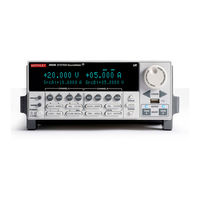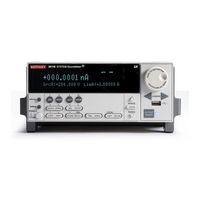Keithley 2612B Manuals
Manuals and User Guides for Keithley 2612B. We have 2 Keithley 2612B manuals available for free PDF download: Reference Manual, Quick Start Manual
Keithley 2612B Reference Manual (864 pages)
2600B series System SourceMeter Instrument
Brand: Keithley
|
Category: Measuring Instruments
|
Size: 21.98 MB
Table of Contents
-
Introduction
21 -
-
-
Front Panel26
-
Rear Panel30
-
-
-
Menu Trees40
-
Main Menu41
-
-
Beeper47
-
Display Mode48
-
-
Saved Setups70
-
Range106
-
Available Ranges106
-
Manual Ranging107
-
Autoranging108
-
Low Range Limits108
-
-
Digits111
-
Speed112
-
Setting Speed112
-
-
-
Relative Offset136
-
Filters138
-
Filter Types138
-
Response Time139
-
-
Reading Buffers141
-
Sweep Operation155
-
Triggering167
-
Timers178
-
Event Blenders184
-
-
Display Features206
-
Display Messages207
-
Input Prompting211
-
Indicators213
-
Local Lockout214
-
Load Test Menu214
-
Key-Press Codes216
-
Digital I/O218
-
Digital I/O Port218
-
Interlock224
-
-
-
-
-
-
Pulse Width254
-
-
Queries256
-
-
Beeper Control257
-
Data Queue258
-
Digital I/O259
-
Display259
-
Error Queue260
-
Event Log260
-
File I/O260
-
Gpib261
-
LAN and LXI262
-
Miscellaneous263
-
Reading Buffer264
-
Reset264
-
Saved Setups265
-
Scripting265
-
Smu266
-
SMU Calibration267
-
Status Model268
-
Time269
-
Triggering270
-
TSP-Link272
-
TSP-Net272
-
Userstrings273
-
-
Factory Scripts273
-
-
-
Introduction288
-
What Is Lua288
-
Lua Basics288
-
-
-
Rename a Script319
-
-
Overview325
-
Connections327
-
Initialization327
-
-
TSP-Net336
-
Overview336
-
-
-
-
Placeholder Text342
-
Syntax Rules343
-
-
TSP Commands347
-
Beeper.beep()347
-
Beeper.enable347
-
Bit.bitand()348
-
Bit.bitor()348
-
Bit.bitxor()349
-
Bit.clear()350
-
Bit.get()350
-
Bit.getfield()351
-
Bit.set()352
-
Bit.setfield()352
-
Bit.test()353
-
Bit.toggle()354
-
Buffervar.n364
-
Dataqueue.add()385
-
Dataqueue.count387
-
Dataqueue.next()388
-
Delay()389
-
Digio.readbit()389
-
Digio.readport()390
-
-
Digio.writebit()398
-
Display.clear()400
-
Display.menu()410
-
Display.numpad411
-
Display.prompt()411
-
Display.screen413
-
Errorqueue.count423
-
Eventlog.all()424
-
Eventlog.clear()425
-
Eventlog.count426
-
Eventlog.enable426
-
Eventlog.next()427
-
Exit()428
-
Filevar:close()429
-
Filevar:flush()429
-
Filevar:read()430
-
Filevar:seek()431
-
Filevar:write()431
-
Format.byteorder433
-
Format.data434
-
Fs.chdir()435
-
Fs.cwd()435
-
Fs.is_Dir()435
-
Fs.is_File()436
-
Fs.mkdir()436
-
Fs.readdir()437
-
Fs.rmdir()437
-
Gettimezone()438
-
Gm_Isweep()438
-
Gm_Vsweep()439
-
Gpib.address440
-
Io.close()446
-
Io.flush()447
-
Io.input()448
-
Io.open()448
-
Io.output()449
-
Io.read()449
-
Io.type()450
-
Io.write()451
-
Lan.autoconnect452
-
Lan.config.speed458
-
Lan.linktimeout459
-
Lan.lxidomain460
-
Lan.nagle460
-
Lan.reset()461
-
Lan.status.speed467
-
Lan.timedwait468
-
Localnode.model480
-
Makegetter()485
-
Makesetter()486
-
Meminfo()487
-
Opc()490
-
Os.remove()490
-
Os.rename()491
-
Os.time()491
-
Print()492
-
Printbuffer()493
-
Printnumber()496
-
Pulseimeasurev()496
-
Pulsevmeasurei()497
-
Reset()500
-
Savebuffer()501
-
Script.anonymous502
-
Script.delete()503
-
Script.load()504
-
Script.new()505
-
Script.restore()506
-
Script.run()507
-
Scriptvar.list()509
-
Scriptvar.name510
-
Scriptvar.run()511
-
Scriptvar.save()512
-
Scriptvar.source512
-
Serial.baud513
-
Serial.databits514
-
Serial.parity514
-
Serial.read()516
-
Serial.write()516
-
Settime()517
-
Settimezone()518
-
Setup.poweron519
-
Setup.recall()520
-
Setup.save()521
-
Smux.abort()521
-
Smux.cal.date524
-
Smux.cal.due525
-
Smux.cal.lock()526
-
Smux.cal.save()529
-
Smux.cal.state529
-
Smux.contact.r()534
-
Smux.measure.y()553
-
Smux.nvbuffery555
-
Smux.reset()556
-
Smux.sense557
-
Sm.source.delay560
-
Smux.source.func561
-
Smux.source.sink571
-
Status.condition594
-
Status.operation610
-
Status.reset()657
-
Status.standard657
-
Status.system659
-
Status.system2661
-
Status.system3663
-
Status.system4665
-
Status.system5667
-
Timer.reset()676
-
Trigger.clear()682
-
Trigger.event_Id682
-
Trigger.wait()690
-
Tsplink.group691
-
Tsplink.master692
-
Tsplink.node692
-
Tsplink.reset()694
-
Tsplink.state695
-
Tspnet.clear()706
-
Tspnet.connect()707
-
Tspnet.execute()709
-
Tspnet.idn()710
-
Tspnet.read()710
-
Tspnet.reset()712
-
Tspnet.timeout713
-
-
Tspnet.write()716
-
Userstring.add()717
-
Userstring.get()719
-
Waitcomplete()720
-
-
-
Next Steps
737 -
Maintenance
738 -
Calibration
743-
Verification743
-
Adjustment760
-
-
-
Overview782
-
LAN Speeds793
-
Duplex Mode794
-
-
Common Commands
803 -
Status Model
808-
Overview808
-
-
-
Index
859
Advertisement
Keithley 2612B Quick Start Manual (19 pages)
System SourceMeter Instruments
Brand: Keithley
|
Category: Measuring Instruments
|
Size: 3.68 MB

